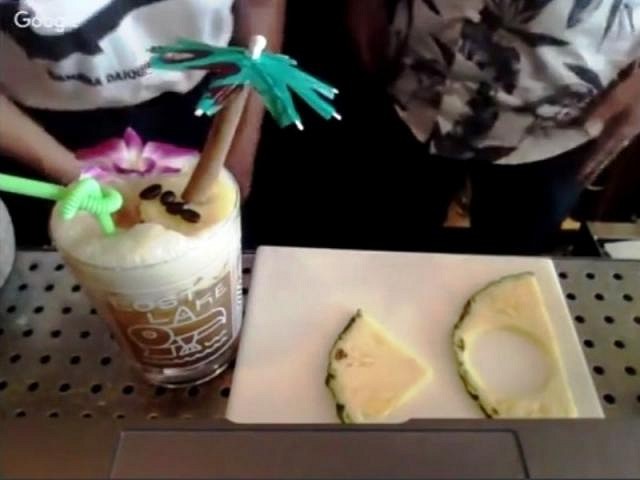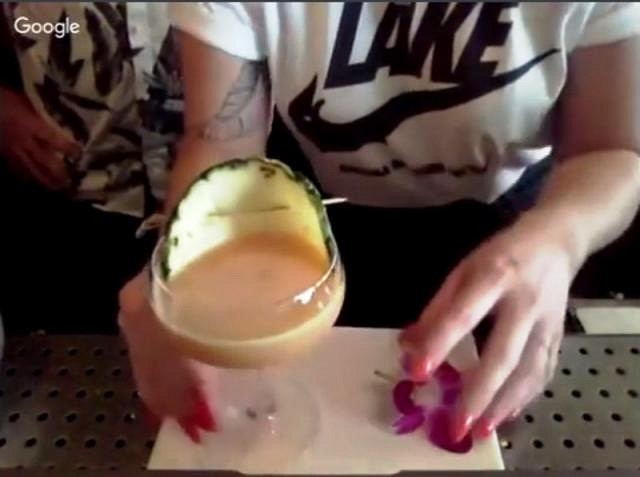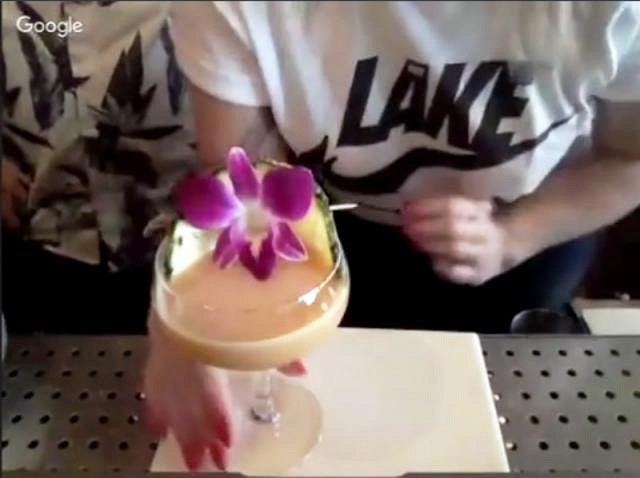M

MadDogMike
Grand Member (8 years)
The Anvil of the Sun
Joined: Mar 30, 2008
Posts: 11248
|
M

Nice article "Tiki Garnish 101" from Lost Lake in Chicago. At the bottom of the page are some video tutorials but they are not a link, you need to copy and paste them.
I thought these 2 garnishes were pretty cool;
Palm tree and Island - Cut a green paper umbrella into a palm tree, stick it into a cinnamon stick for the trunk. Cut a pineapple island and put it at the base of the tree, add a few coffee beans for coconuts. From the video it looks like they just floated the island on the foam of the drink but that doesn't seem very stable. I would put a bamboo BBQ skewer into the bottom of the cinnamon stick so that the skewer rests on the bottom of the glass.

Simple but elegant - cut a thin cross-section half slice of pineapple with the skin on and curl it around the inside of a coupe glass. Put a pick through the pineapple about the liquid level and tuck an orchid or plumeria (real or silk) behind the pick


EDIT - On second thought I decided to copy the article here, insurance against net rot (I just brought over the text, not the pretty pics)
Fact: no one does a garnish like a tiki bar. We love a simple lemon twist or a subtle, restrained expression of orange oil over a classic cocktail, but there's just something about a drink served with a bright, whimsical, completely over-the-top array of florals, fruits, swizzle sticks and paper goods that just feels like pure, old-fashioned fun. From the classic paper umbrella to the more modern banana dolphin, tiki has been at the forefront of garnish innovation since Harry Yee first plucked an orchid flower and placed it in a drink.
Few pay homage to this legacy quite like Lost Lake, Chicago's beloved tiki bar that opened in January 2015. Partners Paul McGee and Shelby Allison ensure that the bar has a seriously impressive garnish game, without ever taking it too seriously. So, we asked the duo to join us for a shakeup and walk us through some of the ins and outs of crowning a cocktail with piranha-shaped swizzle sticks, sailboats made of limes and lemons, and of course, the beloved banana dolphin. Read on to see what they had to say — and for a couple GIF tutorials of their favorite garnishes.
-
When it comes to tiki garnishing, remember: more is more.
One of the things that really differentiates tiki or tropical cocktail garnishes from standard classic garnishes is a more “maximalist” approach. “When we're making classic cocktails like a Negroni or an Old Fashioned, we're trying to be a little bit more minimal where there's not 3-4 ingredients; our garnish is in the glass itself. Usually you're just expressing some oils and discarding and there's a much cleaner look,” says Paul. Shelby adds: “there's nothing frivolous. Nothing for you to take out and put in your hair.” But, as we all know, tiki has plenty of frivolity, which is what makes it so enjoyable. “The fun thing about tiki is that it's really over-the-top, you really have to commit to doing something that's completely different from your typical pre-Prohibition cocktail era bar,” Paul says. “One of the ways to do that is to go completely overboard with the garnishes. It makes it a lot of fun but makes it a lot of work, too.”
-
But, don't forget to keep your guest in mind.
While Lost Lake does follow the “more is more” approach, Shelby adds a cautionary note: “If it makes drinking the drink impossible, that's when it's [become] too much.” She adds that Lost Lake uses bamboo picks to anchor the more top-heavy garnishes into the cocktails so that the whole thing doesn’t plop out of your drink and onto the table as soon as you take a sip. “As long as things are staying in the glass and not prohibiting you from getting every last sip, I think it's fine.”
-
Paper and wood are just as important as fruit and spice.
Lost Lake classifies their garnish material as organic — your standard pineapple, orange peel, cinnamon sticks, and so on — and inorganic, which are the paper parasols, fans, flamingos, lobster picks, and custom piranha-shaped swizzle sticks (not to mention the ceramic glassware). “The reason why we use inorganic materials in our garnishes is because we really think that you taste with your eyes first,” says Shelby. “You see the tray coming towards you, and the very first sip you take is with your eyes: It's a big mug, colorful, filled to the brim with all kinds of stuff. The prettier it looks, the better it tastes.”
-
Garnishes can get complicated, so simplify with a basic template.
In addition to the organic materials that correspond with ingredients in the drink (a pineapple crescent in pineapple drinks, Luxardo cherries with drinks that have maraschino, and so forth), Lost Lake likes to add 2-3 other items to each garnish. “Always the bendy straw,” says Shelby, adding that everyone has their own preference for bending and knotting it. Then, the bar’s custom swizzle stick, and finally, “something paper: an umbrella, a flamingo, a fan,” she says. If it’s a large cocktail meant for sharing, there might be fire, typically executed by pouring 151-proof rum over a piece of toast inside a lime hull. “We do it for the larger formats because you usually have a bigger bowl that’s less dangerous,” says Paul. “If it's a smaller glass, you don't want to put fire in there because it could come dangerously close to your beard or eyebrows.”
-
Proper prep is everything (and smart bar design helps, too).
Lost Lake isn’t a huge bar, but Paul says they can still serve more than 700 cocktails in one shift. “On average, that’s about 100 banana dolphins that get made ahead of time,” he says. The bar was designed, as Shelby puts it, to be “a garnish machine” — the layout includes a 36” bin full of ice, and a 12” bin filled with containers of pineapple crescents, cherries, orange peels, lime hulls, pineapple leaves, orchids, and so forth. “So, we're not opening up a door and having to dig through; everything's at our arm's reach, chilled and fresh the entire shift,” says Paul.
-
Let your staff experiment.
“When we made the banana dolphin for the first time, it was just for a photo shoot, and then our very hardworking servers and bartenders decided to take it upon themselves to make that the actual garnish that went in every drink that has banana,” says Shelby. Paul adds: “I think that's important, too — a lot of times, we'll come up with a garnish, and one of the other bartenders or servers will trump that garnish and make it their own, and it turns out to be way better than my garnish.”
-
But also, make sure staff understands the cost.
An over-the-top garnish towering over a cocktail can add to the drink’s overall cost, which can translate into a higher price for the customer. As a neighborhood bar, Paul wanted to keep Lost Lake’s prices reasonable for regulars. So, the staff is tasked with keeping that in mind when experimenting with new garnishes, and everyone is kept apprised of the exact cost of ingredients. “We let our bartenders know the cost of everything so that they're thoughtful when they're garnishing a cocktail,” he says.
-
Paper garnishes are great for those with tight storage.
Tiki drinks are often kind of complicated, which can be tough when your storage space is limited and you’re working in tight quarters. For bars who perhaps don’t specialize in tiki but would like to have a few drinks on the menu, Paul recommends paper garnishes for one simple reason: they don’t go bad. “We go through about 3,000 orchids a week, and sometimes you'll open up a container and they don't look great, or they're spoiled, or maybe they sat on the truck a little too long in the wintertime and got frozen,” he says. Paper umbrellas and fans, however, stick around and don’t require cold storage. As for where Lost Lake acquires its goods? The pair didn’t explicitly list their sources, but: “You'd be surprised at what your party supplies store has, and also Restaurant Depot,” Paul says.
-
Remember: yesterday’s banana dolphins are tomorrow’s banana daiquiris.
“We try to use underripe bananas [for dolphins] and save the nice ripe ones for the actual drink,” Paul says. “We order two different bananas on each produce order - one specifically for the drink and one for the garnish.” Shelby adds: “We don't usually have leftover dolphins but when we do, they become the next day's drink dolphins.”
And now for a few garnish demos: (fortunately TC automatically made the video links so you don't have to copy and paste)
To make a palm tree on an island:
- Cut your paper parasol into a palm tree.
http://imgur.com/r86JHoo
- Put the parasol stick inside a cinnamon stick, stick that through a pineapple round (which you can cut using a jigger), and place a few coffee beans on the pineapple.
http://imgur.com/d62D33W
- Add bendy straw and orchid.
http://imgur.com/eZBNvjX
To make a boat:
- Make your sails by spearing a bamboo pick through lemon peel.
http://imgur.com/Orjlu5T
- Add your masts to a lime hull.
http://imgur.com/xuC5G7M
To make a planet garnish for The Saturn:
Spear three bamboo picks through a lime hull, and add one Luxardo Maraschino cherry to each pick.
http://imgur.com/SqAGQ63
To make a simple tiki garnish for a coupe glass:
- Place a pineapple crescent into the glass, and pierce on opposite sides with a bamboo pick.
http://imgur.com/amrsNgs
- Place an orchid with a longer, more rigid stem on the pick, resting against the pineapple.
http://imgur.com/Abyby2x
And finally, to make a banana dolphin:
- Remove the tip of the banana and cut a line from the tip for its “mouth.”
http://imgur.com/0rQ09im
- Make small incisions on the sides and top of the banana for its fins.
http://imgur.com/1SoBlSG
- Add eyes using cloves.
http://imgur.com/7knpRrv
- Cut fins from pineapple leaves and place in incisions.
http://imgur.com/v3vOFgc
- Remove the bottom of the banana and insert a coffee stirrer to anchor it in the drink. Add a maraschino cherry to its mouth.
http://imgur.com/1mItSHa
[ Edited by: MadDogMike 2017-12-08 15:03 ]
|



